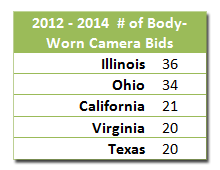State & Local Law Enforcement Agencies Grappling With the Purchase of Body Worn Cameras
The term “body worn camera” is a recent addition to the US public lexicon, due in large part to their somewhat controversial use with local police departments. These cameras are battery powered devices worn by police officers on either their uniform or eyewear. The footage gleaned from the cameras are often used as evidence against suspected criminals with impressive results. The other primary objective is helping to monitor the behavior of each department’s officers, allowing greater transparency and public oversight leading to improved community relations.
The public’s initial reaction seems supportive of this technology and the oversight it inherently provides. The prevailing hope is their deployment will decrease the unnecessary use of force by police officers while improving their own safety and well being. The requests for more transparency in law enforcement have recently begun echoing across the U.S. This new application can become a vital cog in this pursuit.

There has been a steady rise in government agency bids for body worn cameras and this trend has steadily risen over the last three years.

Certain states have spearheaded the the purchases of body-worn cameras as the technology has become more cost efficient to implement. According to BidPrime, a government bid database and research firm, Illinois and Ohio have released the largest number of bids or RFPs for the purchase of body-worn cameras over the last three years. California, Virginia, and Texas follow behind Ohio and Illinois in the overall number of government bids issued over the course of three years.

In 2014, Texas had the highest number of government bids issued for body-worn cameras. Interestingly, most major metropolises in Texas issued bids in 2014, including Houston, Dallas, Fort Worth, and San Antonio. The City of Austin has only issued a Request for Information, but appears poised to issue a larger scale bid in short time.
It is appearing that the public advocates the implementation of these measures. This view is not shared by all, though. Top law enforcement officials like Chuck Wexler, Executive Director of the Police Executive Research Forum (PERF), are urging prudence and that all facets be considered. He stated in a recent PERF letter to its members that “Once an agency goes down the road of deploying body-worn cameras—and once the public comes to expect the availability of video records—it will become increasingly difficult to have second thoughts or to scale back a body-worn camera program.” His assertion that data and opinions from multiple sectors be taken under consideration, before a blind implementation occurs is a pragmatic request. Executive Director Werth, and the PERF membership, would be more supportive once all sides have been through trials, tests, and studies.
It is undeniable that the technology can be a very effective tool in the search for public transparency. Body worn cameras have many benefits for police departments, which is why so many municipal and state law enforcement agencies are already moving towards their purchase. These devices are seen as much more efficient than police car mounted cameras and when a police officer has a body worn camera on his or her person, there can be fewer difficulties or malfunctions.
In fact, the data culled from these cameras is seen as eye-witness worthy proof in a court of law. That was a major step in the acceptance for departments to go live. It should lead to a higher prosecution rate for the police departments that enforce body worn cameras.
There are many aspects needing to be studied and understood such as when the cameras will be activated or what happens when a police officer does not activate the camera. A universally agreed upon series of procedures is not going to happen quickly.
The rise in the bids is quantifiable evidence that the technology is already in use and increasing rapidly. The technology itself raises little cause for concern — it is safe, easy to procure, and durable. However, the implementation of the technology still remains controversial in some circles. The growth in bids and RFPs for body worn cameras portend their continued upward trajectory for the foreseeable future. In light of recent events in the news and public demand, this is an industry to keep an eye on for continued growth in 2015.

Sample Active Bids/RFPs
Body Worn Cameras
For more information, visit BidPrime or call us at 888.808.5356.
